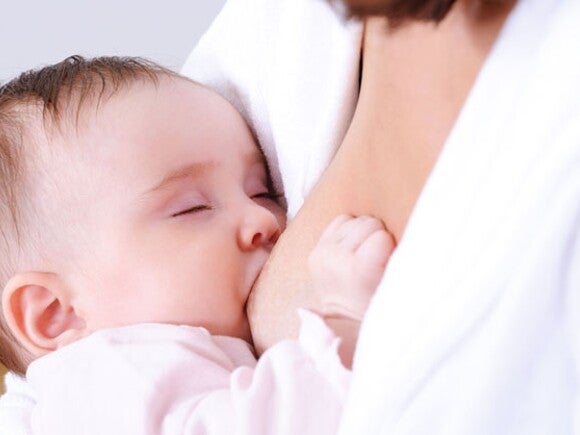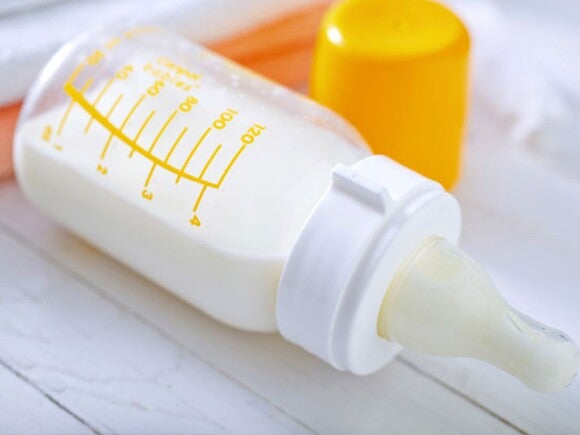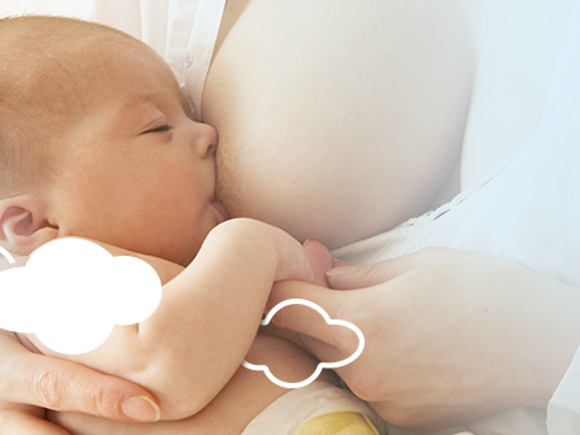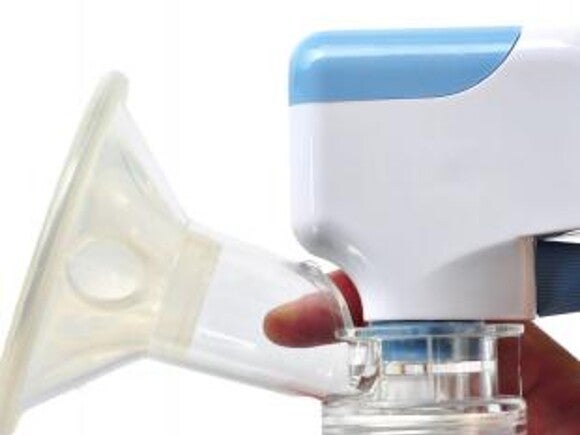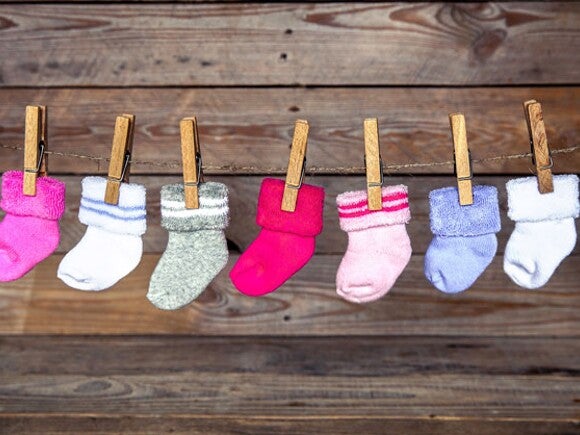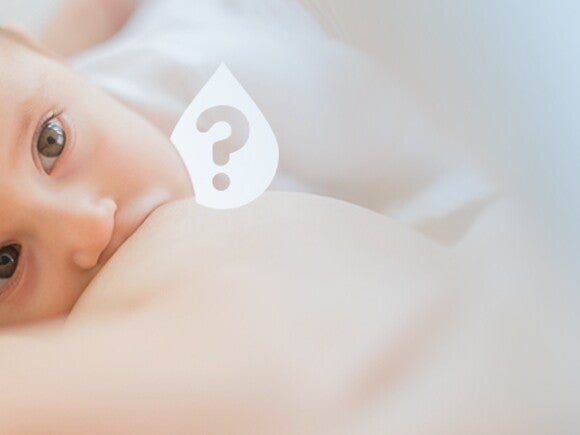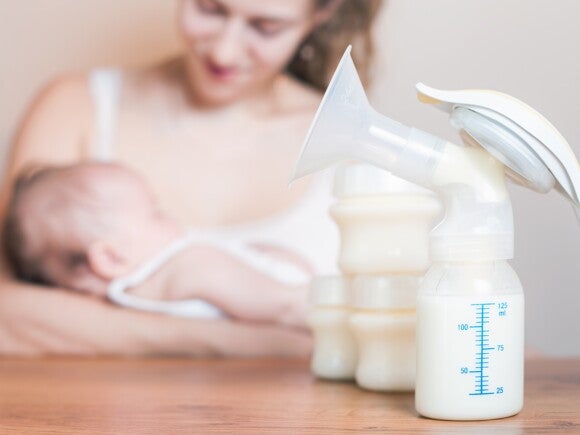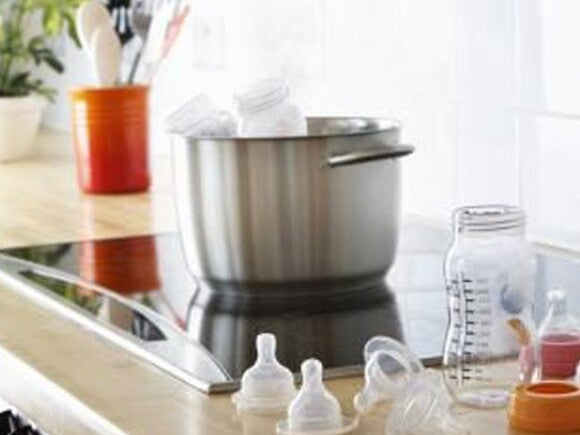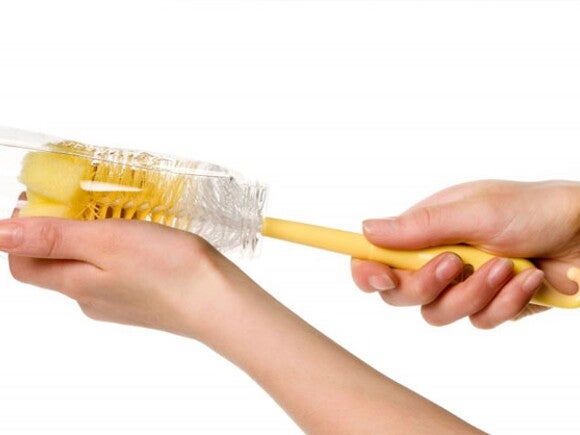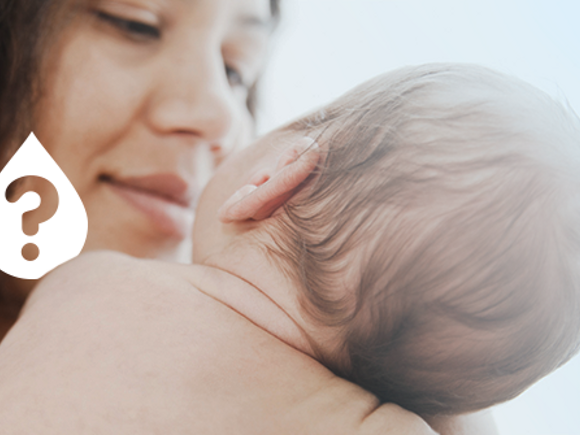Breast pain and tenderness in the early stages of breastfeeding is normal, but it should be temporary and should resolve itself once breastfeeding is established. Below are some useful tips to be aware of if you’re experiencing sore nipples. If your pain doesn’t go away, seek help from an experienced professional in breastfeeding and breastfeeding problems.
Basic remedies
- To give your nipples a break, try skin-to-skin contact between feedings instead of feeding to soothe.
- Get the best attachment. Wait until your baby is calm and begins to look around. This will be a perfect time to help guide them to your breast and get best attachment. If baby's nose is pressed into your breast, lower their body slightly to help their nose come out and chin come into your breast for a better latch. Your baby’s head should not be overly tilted in or back.
- Experiment with different feeding positions such as the “cross-cradle” and “rugby” holds. Both provide a little more head and neck support, which may encourage a better latch.
- Feed baby from the least sore breast first to minimise an aggressive feeding on a sensitive nipple.
- Learn how to get your baby off your breast safely - never pull them off before breaking the suction of the latch. Break your baby’s suction by placing your finger between your breast and their gums before taking them off your breast.
- The pain of a damaged nipple will usually subside as your milk starts flowing, try to trigger a letdown manually before your baby attaches to the breast.
- Breast shields may be of use to some breastfeeding mums and it's best to get professional advice on how and when to use these.
- Express a few drops of breastmilk and rub on your nipples and areola (area around the nipple) after a feed to help protect and soothe tender nipples. Allow your nipples to air dry after feeding as well.
- If you’re using a breast pump, see if it came with different attachments (flange) that will fit your breast better. A lactation consultant may also be able to assess and find a properly fitted flange for you.
- Wear cotton clothing next to your breasts, use a breastfeeding bra or a loose-fitting top.
- If your nipples are too sore to have your bra or clothing touch them, use breast shells with large nipple openings and holes for air circulation over your nipple and under your bra.
- For cracked nipples, apply some expressed breastmilk on your nipples and allow them to air dry.
- Gently wash breasts and nipples with water, and don't use soap or rubbing alcohol, which can dry the skin and cause cracking.
- Try a gentle moisturising balm (for example a lanolin-based barrier cream) to soothe chafed and tender breasts.
- Place a soothing gel patch inside your bra to prevent friction. The patches cool on contact.
- Make sure you replace wet breast pads regularly to avoid infections developing in cracked nipples.
Hard and swollen breasts (otherwise known as breast engorgement) is a normal experience when your milk first comes in. Engorgement after this time can be caused by infrequent or delayed feedings, over-production of milk, poor or inefficient milk removal, supplemental feedings, rapid or sudden weaning, or breast oedema (swelling).
Basic remedies
- Relieve the pressure in your breast as soon as possible by either breastfeeding, gently hand expressing your milk, or using a breast pump. If your breasts are too full for baby to latch on, express a little milk by hand or pump first.
- Breastfeed or pump every two hours to help build a good milk supply while relieving the fullness. Remember, your newborn baby should be breastfed around 8 to 12 times every 24 hours!
- Take a warm shower or place a clean warm, wet cloth on breasts.
- If your baby doesn’t breastfeed long enough to soften them, hand-express or use a breast pump to express more milk until both breasts feel comfortable.
- Use cold packs between feedings.
- If your hands and/or ankles are swollen due to retaining extra fluids, your breasts might also be swollen from retained fluids. Try gently massaging the excess fluid away from the nipple and areola (area around the nipple). Place your fingers and thumb at the neck of your nipple and press into your breast for about a minute. The nipple should become more supple to allow breastfeeding or pumping to be more effective.
You may experience some tingling as your breasts adjust to breastfeeding.
Basic remedies
- If tingling only lasts a few seconds and occurs when your baby starts nursing, don’t worry, it's a normal sign of "let-down”, the release of milk from your breast.
- If the tingling is painful and doesn’t subside, consult your healthcare professional for advice regarding pain relief.
Feeling pain during the first few days? Full breasts during the early days can be caused by the transition from first milk to the surge of mature milk—about 2 to 5 days after birth. Call your healthcare professional if your breasts are painful, hot, have an area of spreading redness or you feel feverish (your temperature is over 38° C). You may have a breast infection or mastitis and require medication.
Basic remedies
- Gently massage the upper part of your breasts.
- Apply a clean warm cloth before feeding, and a cool pack between feedings.
- Take warm showers.
- Breastfeed frequently - at least 8 to 12 times over a 24-hour period.
- Make sure your baby is positioned correctly during each feeding. Your baby should be lying with their whole body facing you.
- Check that your nipple, and as much of the area around the nipple is covered completely with your baby’s mouth, their tongue on the underside of your areola. When removing your baby from your breast, remember to break the suction by gently sliding your finger in between your nipple and their gums.
Is your baby opening their mouth for your breast but not latching on correctly to feed? Common causes could include using bottles or dummies (which have slightly different teats and milk flows), flat or inverted nipples or even an over-tired baby.
Basic remedies
- Where possible, avoid dummies and bottle-feeding for the first three to four weeks to firmly establish breastfeeding.
- Practice skin-to-skin contact as often as possible between feedings to help soothe your baby. Try to help them get a nice deep sleep so they are more rested and interested in the next feeding.
- Recognise your baby’s hunger cues so you can offer your breast as soon as your baby shows they’re hungry.
- Express a small amount of milk from your breast by hand or with a breast pump before feeding to soften the areola and stimulate milk flow, so your baby will receive milk flow right away.
- Try different feeding positions.
- Consider a nipple shield for flat or inverted nipples if the nipple does not stay stimulated even after the use of a breast pump. Ask your lactation consultant about the proper use of a nipple shield. Improper use can result in additional concerns.
Forceful spraying of your milk may result in your baby coughing, gagging and even pulling off the breast. Individual hormone response or overactive milk supply may be the cause of this.
Basic remedies
- Increase your baby’s control of the milk flow by adjusting their feeding positioning to an upright football hold, side-lying hold or a laid-back feeding position.
- Express some milk to catch the initial forceful flow before putting your baby to your breast may be helpful.
- Use of a breast shield to allow for a slight barrier from the milk spray during the initial forceful “let-down” is another option. Proper use of the breast shield is very important and should be discussed with a lactation consultant as to not cause additional concerns due to improper use.
A tender-to-the-touch lump anywhere on your breast or in your underarm area can be signs of a blocked milk duct. Several things may cause a milk duct to get blocked including inadequate feeding (emptying), scar tissue in the breast, underwire bras, tight-fitting bras, or tight-fitting sleeveless tops, or feeding in the same position for all feedings.
Basic remedies
- Your baby is the best at draining the affected breast so continue to feed them often and always offer the affected breast first. As you feed, very gently massage the lump towards the nipple, or simply place a little pressure against the lump.
- Before you feed, apply dry or moist heat to the area by taking a warm shower or applying a warm wet cloth, to help break up the lump.
- If your baby still doesn’t clear the blockage by feeding, try expressing by hand or use a breast pump after you breast feed to further drain the breast.
- Apply gentle massage or pressure to the area during and between feedings.
- Alternate feeding positions to ensure best drainage – your baby’s chin should ideally be on the side of the breast that is affected.
- Use a cold pack (wrapped in a soft cloth) on your breast to relieve pain after a feed.
- Avoid wearing a tight-fitting bra or one with underwire that may hold back milk flow.
- If you haven’t managed to clear the blockage within 12 hours, the lump becomes red and the redness spreads, or you start to feel unwell (as if you’re coming down with the flu), see your GP immediately – you may have mastitis.
Milk “let-down” (release) from your breasts that is delayed and taking longer than 10 minutes, may be due to feeling stressed or anxious about feedings or sitting in an uncomfortable feeding position.
Basic remedies
- Stay relaxed by singing or humming a song, reading a book, or calmly talking to your baby during feedings.
- Gently massage your breast with your hand before putting your baby to your breast.
- Breastfeed your baby in a calm, stress-free environment.
- Adjust to a more comfortable feeding position.
Women may find that their breasts leak milk between feeds. It may be because it’s getting close to feeding time but can also occur as a hormonal response to hearing a crying baby. Which is perfectly normal!
Basic remedies
- Use an absorbent breastfeeding pad or clean folded handkerchief inside your bra to catch the drip. Don’t forget to change it often. A clean pad prevents growth of bacteria, which thrive where it’s warm and moist!
- Place some direct pressure over the nipple of your breast to minimise the response.
- If it’s close to a feed time and your baby is not ready to feed yet, you can hand-express a small amount to relieve the pressure.
It’s very normal to worry about not making enough milk, after all your baby relies on it! The good news is that this is rarely the case and is easy enough to monitor. Your breasts will produce milk based on a supply and demand principle — the more you breastfeed, the more milk you make. Mums of twins for example make twice as much. There are several reasons why milk supply may reduce that has nothing to do with your body’s ability to produce enough breast milk. Some common causes include:
- Formula supplementation.
- Return to work.
- Medications with decreasing milk production as a side effect.
- Significant increased, sudden stress.
- You may be a little dehydrated.
Basic remedies
- Add an extra feeding or pumping session to your daily routine.
- Practice skin-to-skin contact between feedings.
- Practice breast massage before and during feedings.
- Try to relax with your baby and get some rest.
- Take it easy and drink more fluids.
- If you are concerned that your baby is not getting enough breastmilk talk to your doctor for advice
You know your baby is getting enough breast milk when your baby:
- Has a good attachment and settles during and after feeds;
- Is alert, active and happy when awake;
- Has at least six wet nappies in 24 hours (after your milk has come in);
- Passes one or more yellowish, soft bowel motion every day after the initial meconium (first blackish bowel motion) is passed;
- Is gaining weight in line with what your healthcare professional is recommending.
Regular check-ups with your local community nurse, GP or paediatrician for a weight and growth check to ensure your baby is growing and developing correctly is encouraged. Seek help and advice from your support team as soon as you feel there is a problem, early intervention always yields the best outcome.
If your breasts are very full and not “emptied” after full feedings, milk may spray after your baby comes off your breast satisfied. There are a number of symptoms you may see your baby experience if you have an oversupply of milk, these may include your baby:
- Having plenty of wet nappies;
- Having a lot of tummy aches and wind;
- Crying a lot especially after feeds and you notice your milk is flowing very quickly;
- Dropping off the breast and coughing as they can’t keep up with the flow.
This problem doesn’t usually last as your milk supply should adjust to how much milk your baby takes out.
Basic remedies
- If your breast is so engorged your baby finds it hard to latch on, expressing a little milk before the feed to soften the nipple may allow them to attach properly and drain the breast effectively;
- Increase your baby’s control of the milk flow by adjusting the feeding position to an upright football hold, side-lying hold or a laid-back feeding position.
- Feed from one breast per feeding session and pump the other breast only to provide comfort if it becomes uncomfortable between feedings. This may be less than a minute of pumping. Remember at the next feed to start with the alternate breast that is full.
- Take off your bra during feeds to assist with adequate drainage;
- Massage your breast gently while breastfeeding to assist with breast drainage;
- Express a little bit of milk after you feed if your breasts still feel full and uncomfortable. Just be mindful that if you keep doing this it may simply encourage your breast to continue to over produce your milk;
- Place a cold pack wrapped in cloth on your breast to relieve any pain after breastfeeding.
Breast refusal
A baby may refuse the breast for several reasons and can occur at any age, during any feeding session, which can often be distressing for many breastfeeding mums. The good news is that it doesn’t usually last long and normally sorts itself out with some simple changes. Breast refusal may result if your baby is:
- Not actually hungry. Play with your baby for half an hour and wait for hunger signals and try feeding again.
- Over stimulated, over tired or distracted. Try sitting in a darkened quiet room and play some relaxing music.
- Uncomfortable or in pain. Try a new feeding position, give your baby a warm bath or rub their back to ease a tummy pain.
- Unwell and irritable. Check your baby’s temperature and seek medical help if elevated. Try feeding when your baby is first stirring or even still asleep.
- Affected by a change in the taste of your milk. This may be due to any new medication; or hormonal changes as your periods return; or if you have eaten something with a strong taste that your baby doesn’t enjoy yet.

